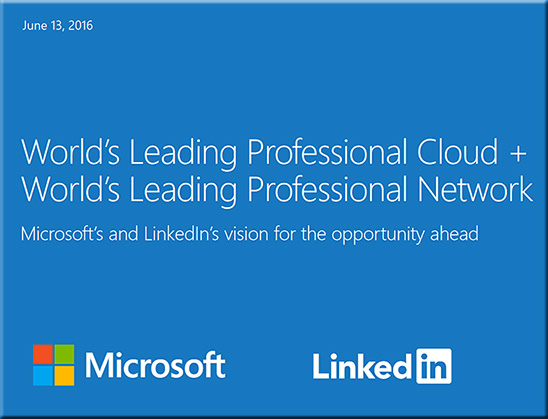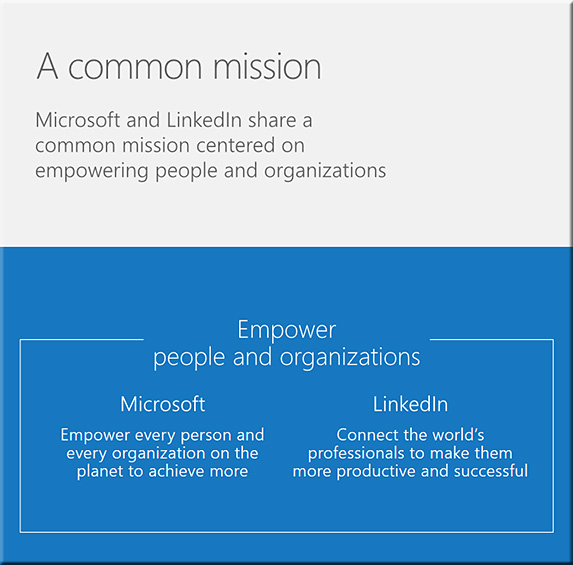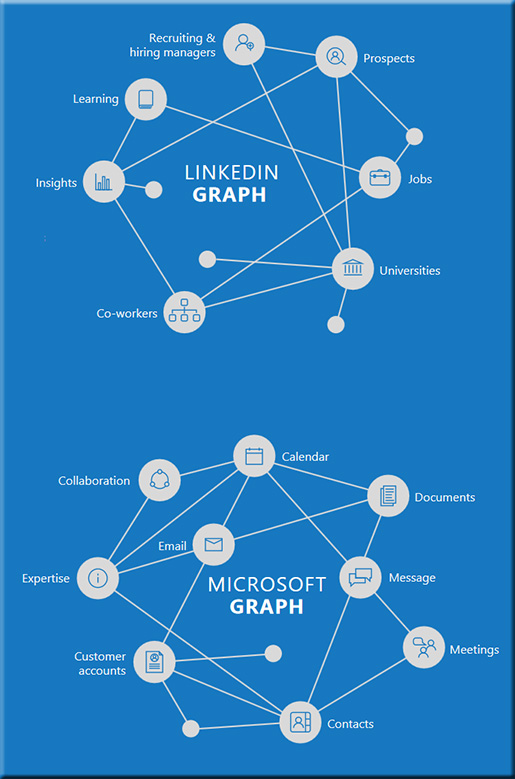From Microsoft and LinkedIn:
Microsoft and LinkedIn: Together changing the way the world works — from blog.linkedin.com
Excerpt:
Today [6/13/16] we are excited to share that LinkedIn has entered into an agreement to be acquired by Microsoft. We are joining forces with Microsoft to realize a common mission to empower people and organizations. LinkedIn’s vision – to create economic opportunity for every member of the global workforce – is not changing and our members still come first.
Our companies are the world’s leading professional cloud and network. This deal will allow us to keep growing, investing in and innovating on LinkedIn to drive value for our members and our customers. Our members will continue to develop their skills, find a job and be great at that job, using our platform. We will continue to help our customers hire top talent, market their brand, and sell to their customers.
From DSC:
It’s interesting to reflect upon what this acquisition could mean and what it could bring to the workplace/career development table.
LinkedIn.com purchased/acquired Lynda.com (announced in April 2015), a growing/thriving (online-based learning) training and development company who can deliver lifelong learning and credentials to people…which continues to help people reinvent themselves.
LinkedIn.com is working on an economic graph, a digital mapping of the global economy…building a database/marketplace of job openings and people who can fill those jobs.
What is the Economic Graph?
The Economic Graph is, in short, a digital mapping of the global economy. It will include a profile for every one of the 3 billion members of the global workforce, enabling them to represent their professional identity and subsequently find and realize their most valuable opportunities. It will include a profile for every company in the world, who you know at those companies up to three degrees to help you get your foot in the door, and the product and services those companies offer to enable you to be more productive and successful. It will digitally represent every economic opportunity offered by those companies, full-time, temporary and volunteer, and every skill required to obtain those opportunities. It will include a digital presence for every higher education organization in the world that can help members obtain those skills. And it will overlay the professionally relevant knowledge of every one of those individuals, companies, and universities to the extent that they want to publicly share it. Learn more about the Economic Graph and join the discussion.
Now Microsoft is purchasing/acquiring LinkedIn.com and the data/endeavors/technologies/platforms LinkedIn.com has been working on.
(Add to that the fact that Microsoft has been working on artificial intelligence (AI), personal assistants (i.e., Cortana). It has been working on other forms of HCI as well, such as HoloLens.)
Therefore, some questions come to my mind:
- Will the purchase of LinkedIn.com now add a potentially huge new reason to choose their platform/ecosystem as well? In fact, Microsoft could be expanding their platform/ecosystem — or creating a new platform — to take advantage of using AI, personal assistants, and big data to play the ultimate match maker in the workplace.
- Will freelancers utilize their services to find work? (The use of freelancing continues to grow; already in the mid-30 percents of the American workforce now.)
- Will Microsoft be a source of cloud-based learner profiles?
- Will Microsoft now get into the credentialing business? Will Microsoft employ blockchain-based technologies? (Higher ed, take note if so.)
- How will badges/badging play into this platform?
- Will Microsoft work with companies to offer assessments into whether person A can be successful in position B?
- What will this mean for lifelong learning?
Hmmmm….time will tell.
Addendums later on 6/13/16
Excerpt from this article:
Nadella explained it in a sentence to Business Insider’s Matt Rosoff Monday morning.
He said that buy buying LinkedIn’s professional network:
“It helps us differentiate our CRM product with social selling. It helps us take Dynamics into new spaces like human capital management with recruiting, and learning, and talent management.”
He later told analysts that connecting LinkedIn data with Dynamics [Microsoft’s suite of business management software] is “where the magic starts to happen.”
Excerpt from this article:
Think about it: How people find jobs, build skills, sell, market and get work done and ultimately find success requires a connected professional world. It requires a vibrant network that brings together a professional’s information in LinkedIn’s public network with the information in Office 365 and Dynamics. This combination will make it possible for new experiences such as a LinkedIn newsfeed that serves up articles based on the project you are working on and Office suggesting an expert to connect with via LinkedIn to help with a task you’re trying to complete. As these experiences get more intelligent and delightful, the LinkedIn and Office 365 engagement will grow. And in turn, new opportunities will be created for monetization through individual and organization subscriptions and targeted advertising.











